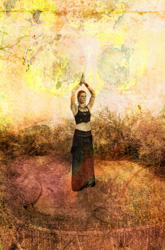Most of us fear being judged on some level. It doesn’t feel good at all, and depending on how much emotion is attached, it can feel really awful. Most of us, however, tend to do it to other people or events. While we can’t easily control being judged by others, we can learn to shift what we do ourselves in our daily situations and that can improve the quality of our lives. It doesn’t mean that you just “accept all that comes your way.” What it means is that you stand back and try to see what is motivating you to decide if something is right or wrong for you, shifting from judgment to discernment. Following are some steps you can take to do that, but first let me explain the difference between the two.
Let’s say you are an interior designer. Your client is color blind, but knowing that green will represent “healthy and organic” for his new store, has decided that he wants all the items in a particular room to be green. He can’t see the difference between green and blue. Your job is to select only green items, using your ability to discern between the two colors. There is no emotional judgment involved in this; it is just a simple matter of observation and choices.
But let’s say your mother always dressed you in green when you where a child and everyone in school made fun of you. Now when you look at something that is green, it inspires a negative emotional judgment about the color. It puts your emotional body into negative vibration mode and out of sync with the rest of you. It takes you away from your higher source. If that happens and you are aware of it happening, you have to work at bringing yourself back into balance or spend the rest of the day “out of sorts.”
So if you find yourself “not liking” something, step back and evaluate what is going on with you, what is the reason for the reaction. Ask yourself:
1. Is this opinion based on prior experience about this subject?
2. Does the situation evoke a twinge in my belly?
3. Am I thinking about what OTHERS would think of choosing or not choosing the situation?
4. Have I rationally thought about the pros and cons of this subject?
Too often we have to make snap decisions, and there may not always be time to go through these questions, but if you practice when you have time to ponder something, it will in time become second nature to you and you will run through the questions in a flash of a second. If your answer was “yes” to 2. or 3., it is likely that you are in a state of being judgmental, or having an emotional reaction to the situation that might have nothing to do with the current situation. So what is wrong with that you ask? You might just make the wrong choice. You might let some past experience stop you from what could be a very good experience for you…now, with this new situation…not the old one in your emotional memory banks.
When you are pointing your finger at someone else in judgment, energetically you are pointing THREE fingers back at your self. Being more tolerant of people or situations that aren’t living “up to your standards” will not draw those types of people toward you. Not being tolerant just might! We are learning how our own energy draws certain things to us and repels others. So if you are in a state of being emotionally judgmental, you are going to attract people that are also in that state around you…inviting them to judge you.
Our emotions play a very important role in our lives, as long as they are in balance. Feeling love and joy are very positive experiences to be sure. If you are feeling anger or fear, those feelings may be protecting you from something about to cause you harm. What is good for us to learn is if what we are feeling, be it love or fear, is really about the situation immediately in front of us or about something that happened in our past. Thinking that you are “in love” with someone who reminds you of a past love can match you up with the wrong person. If you are in a state of fear, lets say of being fired from your job, if that fear stems from a previous experience when you were actually fired, not this situation, you may react inappropriately and actually get yourself fired again!
Don’t be discouraged if learning to master this “discernment” about your emotions takes some time. But taking the time to try to see the difference can’t help but make your life better, help you make better choices. Just think about it next time you are in a state of judgment. Run through these four simple questions and see what is really going on with you. We all have this ability, we just have to

 The intention of this article is to guide you through the four stages of every transitional cycle and provide you with strategies to support you as you move through each moment of your experience. Begin the New Year with a deeper understanding of the four stages of life-altering transformation.
The intention of this article is to guide you through the four stages of every transitional cycle and provide you with strategies to support you as you move through each moment of your experience. Begin the New Year with a deeper understanding of the four stages of life-altering transformation.
Feedback